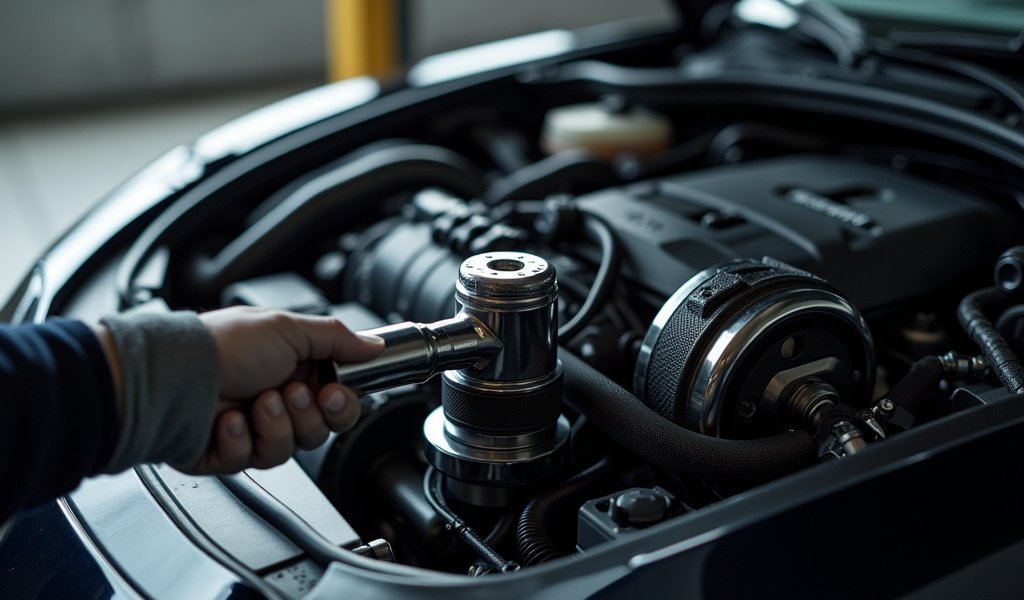Overview
This article provides a detailed guide on properly adjusting supercharger belt tensioners, explaining how correct tension is crucial for optimal performance and longevity of forced induction systems. It covers signs of tension problems, necessary tools, step-by-step adjustment procedures for both automatic and manual tensioners, common mistakes to avoid, and maintenance best practices to ensure reliable supercharger operation.
Table of Contents
- Understanding Supercharger Belt Tensioners
- Signs You Need a Tensioner Adjustment
- Tools and Preparation
- Step-by-Step Adjustment Guide
- Common Mistakes to Avoid
- Maintenance Tips
- Conclusion
- Frequently Asked Questions
Understanding Supercharger Belt Tensioners
Let me tell you something about supercharger belt tensioners that might surprise you – they’re actually the unsung heroes of your forced induction system. I’ve been working on supercharged engines for over 15 years now, and proper supercharger belt tensioner adjustment makes all the difference between a screaming, tire-shredding beast and a temperamental, power-robbing headache.
Think of your supercharger belt tensioner as the Goldilocks of your engine bay – it needs to be just right. Too loose, and your belt slips under load, robbing you of precious boost and potentially damaging your system. Too tight, and you’re putting excessive strain on bearings, pulleys, and the belt itself, leading to premature failures and that sinking feeling when you hear something snap under the hood.
The tensioner’s job is deceptively simple: maintain the perfect amount of pressure on your supercharger belt as it transfers power from your crankshaft to your supercharger pulley. However, getting this adjustment right requires understanding both the mechanical principles at play and the specific requirements of your vehicle’s setup.
Most supercharger systems use one of two types of tensioners: automatic spring-loaded tensioners that self-adjust (common on factory supercharged vehicles), or manual tensioners that require periodic adjustment (often found on aftermarket setups). Either way, knowing how to check and adjust your tensioner is essential knowledge for any supercharger owner.

Signs You Need a Tensioner Adjustment
Your supercharged ride has ways of telling you when the belt tensioner needs attention. The most obvious sign is that characteristic squealing noise during acceleration – it’s the sound of your belt crying out for help as it slips across the pulleys. This typically happens when you hit the throttle and demand more boost, putting sudden strain on an insufficiently tensioned belt.
Another telltale indicator is unexplained power loss. If your car feels sluggish or doesn’t pull as hard as it used to, a slipping belt might be robbing your supercharger of its ability to build proper boost. I’ve seen customers chase phantom fuel system or ignition issues when the real culprit was simply an improperly tensioned supercharger belt.
Visual inspection can reveal a lot, too. Look for these warning signs:
- Glazed or shiny spots on the belt (indicates slippage)
- Frayed edges or visible cracks in the belt material
- Excessive belt movement or vibration at idle
- Belt dust or rubber particles around pulleys
- Uneven wear patterns across the belt width
Pay attention to unusual noises, especially a high-pitched whine that changes with RPM or a chirping sound that wasn’t there before. These acoustic warnings often precede more serious issues, and addressing them promptly can save you from costly repairs down the road.
Trust your senses – if something seems off with your supercharger’s performance or sound, a tensioner adjustment is often the first place to look. I’ve saved customers thousands in unnecessary parts replacements by simply correcting their belt tension.
Tools and Preparation
Before diving into any supercharger belt tensioner adjustment, gathering the right tools will make your life infinitely easier. I learned this lesson the hard way years ago when I tried to adjust a tensioner with improper tools and ended up with bloodied knuckles and a still-malfunctioning supercharger.
For most supercharger belt tensioner adjustments, you’ll need:
- Socket set with ratchets (both standard and metric to cover all bases)
- Torque wrench for precise tensioning
- Belt tension gauge (specific to your manufacturer’s specs)
- Breaker bar for stubborn bolts
- Good quality flashlight or headlamp
- Clean shop rags
- Penetrating oil for stubborn fasteners
Some vehicle-specific setups might require additional specialized tools like serpentine belt tools or pulley holders. A quick check of your vehicle’s service manual or a reputable video tutorial can confirm if you need anything special before starting.
Safety first! Make sure your engine is completely cold before starting work. Working on a hot engine is not only uncomfortable but can lead to inaccurate tension settings as components expand and contract with temperature changes. Also, disconnect the negative battery terminal to prevent any accidental engine starts while your hands are near moving components.
Create a clean, well-lit workspace. I prefer to take before photos with my phone to reference during reassembly – this simple habit has saved me countless headaches over the years. It’s also wise to place a plastic tray or cardboard under your work area to catch any dropped fasteners.
Finally, consult your vehicle’s service manual or tensioner replacement guide for the specific tension specifications. Every supercharger setup has its own ideal tension range, and guesswork just won’t cut it here.
Step-by-Step Adjustment Guide
Alright, let’s roll up our sleeves and get that supercharger belt tensioner dialed in perfectly. I’ll walk you through the process like I would if we were standing in my shop together.
First, locate your tensioner. Depending on your vehicle, this might be obvious or somewhat hidden. On most vehicles, the tensioner is a pulley mounted on an adjustable bracket or arm located somewhere along the belt path. If you’re having trouble finding it, consult your service manual – it’ll save you time and frustration.
Once you’ve identified the tensioner, you’ll need to determine whether you’re dealing with an automatic (spring-loaded) tensioner or a manual adjustment type:
For Automatic Tensioners:
1. Visually inspect the tensioner for signs of wear or damage. Look for cracks in the casting, leaking hydraulic fluid, or excessive movement.
2. Use a wrench or socket on the tensioner bolt to rotate the tensioner against its spring tension. This relieves pressure on the belt.
3. While holding the tensioner in the relaxed position, check the belt for wear and ensure it’s properly seated in all pulley grooves.
4. Slowly release the tensioner, allowing it to apply tension to the belt naturally.
5. Observe the tensioner’s position relative to any indicator marks. Many factory tensioners have marks showing the acceptable range of movement. If the indicator is outside this range, your belt may be stretched and in need of replacement.
For Manual Tensioners:
1. Slightly loosen (but don’t remove) the mounting bolts that secure the tensioner to the engine. This typically requires a socket and ratchet.
2. Use your belt tension gauge to measure the current tension. Place it at the longest span of the belt between pulleys for the most accurate reading.
3. Compare your reading to the manufacturer’s specifications. Remember, these specs are not suggestions – they’re engineered requirements for optimal performance.
4. To adjust tension, use a pry bar or tensioner tool to move the tensioner, increasing or decreasing belt tension as needed. I find it helpful to have a second person take measurements while I hold the tensioner in position.
5. Once you’ve achieved the specified tension, carefully tighten the mounting bolts to the torque specified in your service manual. Always use a torque wrench here – proper fastener torque is just as important as proper belt tension!
6. After tightening, recheck your tension. The act of tightening can sometimes shift the tensioner slightly, changing your carefully set tension.
For both types, after adjustment, start the engine and observe the belt operation. Listen for unusual noises and watch for excessive movement. A properly tensioned belt should run smoothly without visible flutter or vibration.
Let the engine run through a few heat cycles, then check your adjustment again when cool. Some settling is normal, and a follow-up fine-tuning might be necessary for perfect results. This is especially important for high-performance applications where precision matters most.

Common Mistakes to Avoid
In my years working on supercharged engines, I’ve seen plenty of well-intentioned folks make the same mistakes when adjusting their belt tensioners. Let me save you some trouble by highlighting what NOT to do.
Overtightening is perhaps the most common error. I understand the impulse – you don’t want the belt to slip, so tighter must be better, right? Wrong. Excessive tension dramatically increases wear on bearings, puts stress on brackets and components, and can actually shorten belt life rather than extending it. Trust the manufacturer’s specifications, which have been carefully calculated for optimal performance.
Another mistake is neglecting to check tension after the engine has gone through several heat cycles. Belt tension can change as components expand and contract with heat, so what seemed perfect in your garage might be too loose or tight after a spirited drive. I always recommend rechecking your adjustment after a few heat cycles.
Many DIYers also forget to inspect related components while they’re already in there. Since you’ve gone to the trouble of accessing the tensioner, take a moment to check pulley alignment, inspect all bearings for smooth operation, and examine idler pulleys for signs of wear. This comprehensive approach can catch developing issues before they become failures.
Using the wrong belt is another pitfall. If you’re replacing your belt during this process, make absolutely sure you’re using the correct length and type for your specific application. Even a small deviation in belt length can make proper tensioning impossible. And always use high-quality belts from reputable manufacturers – this is not the place to save a few bucks.
Finally, a mistake I see even experienced mechanics make is failing to document their work. Take “before” measurements so you have a baseline, and note down your final tension setting for future reference. This simple habit can make future maintenance much easier and helps track changes over time.
Maintenance Tips
Taking care of your supercharger belt tensioner isn’t a set-it-and-forget-it affair. A little ongoing attention can prevent major headaches down the road. Let me share some practical maintenance wisdom I’ve gathered over the years.
First, establish a regular inspection schedule. For daily drivers, I recommend checking your supercharger belt tensioner adjustment every 5,000-10,000 miles or whenever you change your oil. For high-performance or track vehicles, check before any serious driving session. These regular check-ups catch issues before they develop into problems.
Keep the belt and pulley system clean. Oil, coolant, and other fluid leaks can degrade rubber belts rapidly and change friction characteristics, leading to slippage even with proper tension. If you notice fluid contamination, address the source leak promptly and consider replacing a contaminated belt rather than trying to clean it.
Listen to your car. Modern engines are remarkably quiet, which means unusual sounds often stand out. Take a moment periodically to listen to your engine at idle with the hood up, paying particular attention to any noises that might be coming from the belt system. Your ears can often detect developing issues before they’re visible.
Consider belt replacement as preventative maintenance rather than emergency repair. Most supercharger belts should be replaced every 60,000 miles as a maximum, but many performance applications benefit from more frequent replacement. When replacing, always adjust the tensioner to specifications rather than simply matching the tension of the old belt.
Keep a record of your maintenance activities. Note when you check tension, what the readings were, and any adjustments made. This documentation helps identify patterns and can alert you to developing issues, such as a tensioner that requires increasingly frequent adjustment.
Finally, remember that environmental factors play a role in belt life and tensioning needs. Extremely cold or hot climates can affect rubber compounds and tension requirements. If you’ve relocated to a significantly different climate, consult with a specialist mechanic familiar with local conditions to see if your tensioning strategy needs adjustment.
By following these maintenance practices, you’ll not only extend the life of your supercharger components but also ensure consistent performance and reliability from your forced induction system. As we say in the shop, “An ounce of prevention is worth a pound of boost!”
Conclusion
Proper supercharger belt tensioner adjustment might seem like a small detail in the grand scheme of vehicle maintenance, but it’s one of those critical factors that separates trouble-free performance from frustrating breakdowns. Throughout my career, I’ve seen countless supercharger issues traced back to improper belt tension – problems that could have been easily prevented with the knowledge I’ve shared today.
Getting this right isn’t just about avoiding problems; it’s about unlocking the full potential of your supercharged engine. A correctly tensioned belt delivers power efficiently, maintains consistent boost, and gives you that seat-of-the-pants acceleration that made you choose a supercharged vehicle in the first place.
Remember that supercharger belt tensioner adjustment isn’t a one-time task but part of an ongoing relationship with your vehicle. Regular checks, attentive maintenance, and prompt addressing of any issues will reward you with reliable performance and fewer unexpected repair bills.
Whether you’re a DIY enthusiast or someone who prefers to have a professional handle maintenance, understanding the importance of proper tensioning empowers you to make informed decisions about your vehicle’s care. That knowledge is invaluable whether you’re under the hood yourself or communicating with your mechanic about what your car needs.
So take the time to get this right. Your supercharger will thank you with years of trouble-free boost, and you’ll enjoy the peace of mind that comes from knowing your forced induction system is operating exactly as engineered. After all, isn’t that confidence what performance driving is all about?
Frequently Asked Questions
How do I know if my supercharger belt is too loose?
Listen for squealing noises during acceleration and check for visible belt movement or flutter. You might also notice decreased performance or boost pressure if the belt is slipping under load.
Can a supercharger belt be too tight?
Absolutely – excessive tension can damage bearings, cause premature belt failure, and even bend brackets. Always follow manufacturer specifications rather than assuming tighter is better.
How often should I check my supercharger belt tension?
For daily drivers, check every 5,000-10,000 miles or during oil changes. Performance vehicles should be checked more frequently, especially before track days or aggressive driving sessions.
What’s the average lifespan of a supercharger belt?
Most manufacturers recommend replacement every 60,000 miles, but this varies by application and driving conditions. High-performance applications may require more frequent replacement around 30,000-40,000 miles.
Can I adjust my supercharger belt tensioner myself or should I see a mechanic?
With proper tools and knowledge, many enthusiasts can perform this maintenance themselves. However, if you’re unsure or uncomfortable with the procedure, professional help ensures it’s done correctly and prevents costly mistakes.

